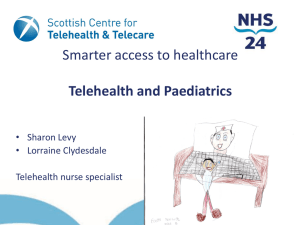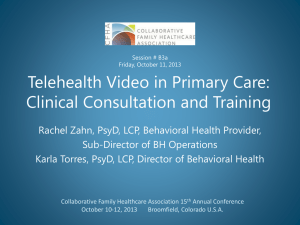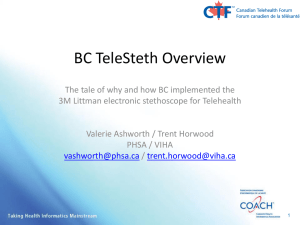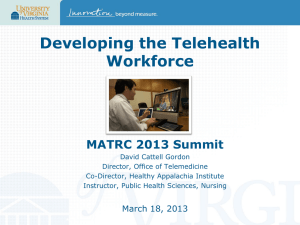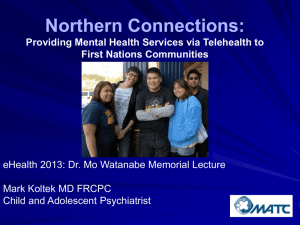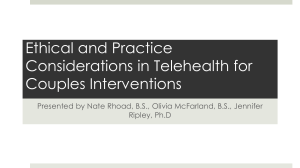Collaborative Family Healthcare Association
advertisement
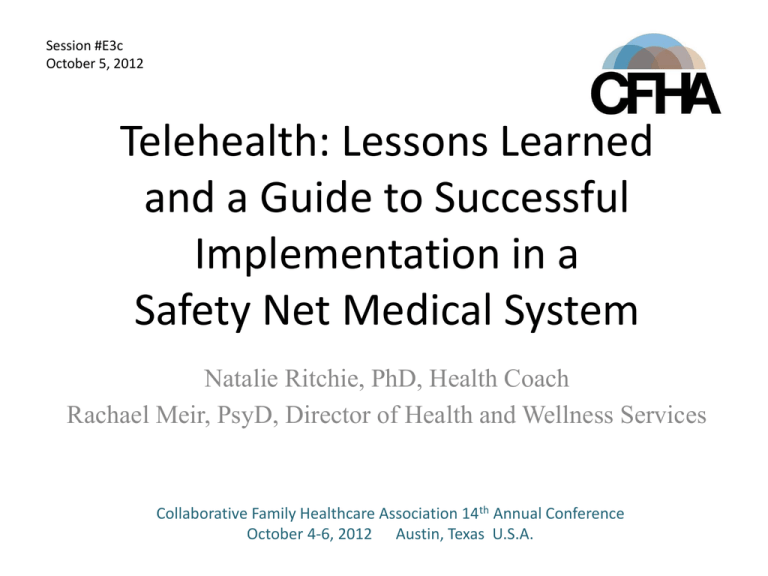
Session #E3c October 5, 2012 Telehealth: Lessons Learned and a Guide to Successful Implementation in a Safety Net Medical System Natalie Ritchie, PhD, Health Coach Rachael Meir, PsyD, Director of Health and Wellness Services Collaborative Family Healthcare Association 14th Annual Conference October 4-6, 2012 Austin, Texas U.S.A. Faculty Disclosure We have not had any relevant financial relationships during the past 12 months. Objectives • Describe barriers to implementing a telehealth intervention for underserved populations. • Identify solutions to implementing telehealth interventions more effectively for underserved populations. • Identify strategies to provide integrated, interdisciplinary care using telehealth interventions. • Discuss future research needed to develop effective telehealth practices for use in interdisciplinary settings. Learning Assessment A learning assessment is required for CE credit. Attention Presenters: Please incorporate audience interaction through a brief Question & Answer period during or at the conclusion of your presentation. This component MUST be done in lieu of a written pre- or post-test based on your learning objectives to satisfy accreditation requirements. Overview • Telehealth is an important emerging modality for healthcare interventions with potential to remove barriers to care for underserved populations. • We implemented a telephonic depression intervention within a safety net hospital, designed to enhance treatment as usual by primary care providers. • Although successful in many areas, we encountered implementation challenges that demonstrate a need to systematically improve telehealth methodology for use in underserved populations. • We propose a preliminary guide for implementing telehealth interventions within safety net medical systems. Barriers to Care in Safety Net Medical Systems • Institutional barriers: – Resistance to offering treatment for public insurance or sliding-scale payment programs (Cook et al., 2007). – Limited availability of primary and specialty care appointments (Phillips, Mayer, & Aday, 2000; Cook et al., 2007). – High no-show rates, which can reduce efficiency and revenue (Moore, Wilson-Witherspoon, & Probst, 2001). • Patient barriers: – Limited insurance or ability to pay treatment costs (Cook et al., 2007). – Lack of transportation and childcare (Uebelacker, Marootian, Pirraglia, Primack, Tigue et al., 2011). – Barriers to mental health treatment further include stigmatized perceptions of endorsing a behavioral health “problem” and difficulty disclosing sensitive information (e.g., Crisp, Gelder, Rix, Meltzer, & Rowlands, 2000). Telehealth as a Solution • Telehealth allows institutions to offer more cost-effective care by: – Lowering costs of administrative and reception personnel, waiting areas, and patient care rooms. – Reducing problematic no-show rates – telehealth can be implemented without a pre-set appointment schedule, allowing clinicians to optimally target multiple patients at a given time. • Telehealth benefits patients by: – Eliminating need for transportation and childcare. – Increasing access to care through lower costs, provider availability, extended coverage to underserved geographical regions. – Reducing stigma associated with being seen in a mental health clinic. – Facilitating willingness to disclose personal information. Telephonic Depression Intervention (TDI) • We used telehealth to increase access to integrated mental health services for primary care patients suffering from depression. • Overall aim was to enhance PCP’s treatment of depression by: (1) Providing evidence-based psychotherapy (2) Improving adherence to antidepressant medications (3) Improving depression outcomes (4) Identifying previously undiagnosed psychiatric comorbidities (5) Providing feedback to PCPs on depression outcomes and management recommendations • We recruited >300 patients for a 6-month study with half randomized to receive assessments only (control group) and half to also receive five therapy calls (intervention group). Our Recruitment Practices • Identification: – PCP-initiated referrals – Self-referrals – Pharmacy-generated lists of patients receiving antidepressants from PCPs • Recruitment: – – – – Post flyers and posters throughout clinics Circulate electronic newsletters on study aims and progress Present at clinic meetings Contact potential participants with up to two phone calls and a letter • Enrollment: – Screen for eligibility criteria and complete mental health assessment – Obtain consent to continue Enrollment Status from 5/1/11 to 7/1/12 (N = 5,086) Self Total identified No contact attempted Successful enrollment Opt-out Ineligible Unable to contact n % 26 10 5 1 7 3 --31% 6% 44% 19% Referral Source Provider % n 167 7 45 6 55 54 --28% 4% 34% 34% Pharmacy % n 4,893 2,870 142 38 1,238 605 --7% 2% 61% 30% Encourage Provider-Initiated Referrals • We administered anonymous questionnaires to 41 PCPs: – 71% referred at least one patient to TDI – 50% would refer majority of depressed patients in the future – 39% had difficulty remembering to refer to our program • Recommendations: – – – – Attend clinic meetings regularly. Circulate reminder emails and electronic newsletters. Offer an electronic, automatic referral system. Obtain more input from PCPs to develop telehealth interventions, so interventions better meet their needs and patient needs. – Reinforce provider participation, such as offering recognition to providers who support program enrollment. Recommendations for “Cold-Calls” • Limit initial investment in potential participants: – Provide telehealth clinicians with access to patient medical records– allows early disqualification by identifying exclusionary criteria (e.g., bipolar disorder) in advance. – Limit contact attempts to one call. – Provide clinician contact information and request a call back, rather than offering to call back, if patient notes inconvenient time. – Use mass mailings, requesting a response back to indicate interest. • Out of 120 mailings to pre-identified patients, 38% (n = 45) noted interest by returning a postcard and/or calling in. – Consider IVR technology. Interactive Voice Response (IVR) • IVR technology can be used as an efficient recruitment method for large target populations: – Informs large samples about available healthcare programs with limited time investment. – Can create a pre-identified list of interested participants. • We had overall success using IVR with other departmental programs: – 38.1% (n = 469) of contacted patients answered and listened to entire message. – 12.2% (n = 150) proceeded to take phone survey. – IVR was most frequently cited method of learning about our programs among health information seminar attendees (compared to mailings, flyers, etc). – However, limited use for sign-up process as used. Our Retention Practices • Numerous calls required to complete program (up to 10). • Our initial methodology included scheduling therapy calls, as consistent with face-to-face counseling practices. • Contact attempts for each call included up to two phone calls, followed by a letter requesting a call back. • Sent mailings in between calls, including symptom changes and behavioral plans. • Retention was 72% as of 3/30/12. – 141 out of 195 completed the study Retention Recommendations • Limit length and total number of telehealth calls within the needs of quality care practices. • Schedule an appointment window– ask participants to select a block of available time for the next telehealth call (e.g., Friday from 2-4p). • Request contact information in advance for two family members or friends who may be reached to assist in the event of changed or disconnected phone numbers. • Mail letters after unsuccessful contact attempts by phone: – We sent 87 UTCLS from 2010-2011, which appeared to contribute to retention in 40% (n = 35) cases. • Encourage providers to reinforce program engagement. • Provide a flyer with staff photos and names to increase participant rapport and sense of accountability toward clinicians. Christine David Laura Rachael Catherine The Telephonic Depression Intervention (TDI) program has been developed by clinicians at Denver Health to improve the health of patients such as you. We know that patients who participate in programs like this are likely to experience better outcomes. Participation in this program will help us track how you are responding to the medications prescribed by your primary care provider and should help you learn new ways to cope with stress and depression. Your TDI team thanks you for participating! Courtney Chris Natalie Rob Integrating Telehealth Care • Our practices: – Emails to PCPs at initial enrollment or disqualification, and 6-, 12-, and 24weeks, including depression severity, medication recommendations, and comorbidities. – Entered Provider Feedback Report Form into medical records • 80.5% of PCPs noted reviewing our emails and/or medical record notes • Recommendations: – Routinely provide consulting information to PCPs, both in email for immediate access and medical record for later viewing. – Provide tips for PCPs to reinforce patient goals. – Encourage three-way communication between PCP, telehealth clinician, and patient. – Schedule follow up appointments with PCPs if needed. Conclusion and Future Directions • Telehealth has potential to be an effective care modality for underserved populations. • However, telephonic care is a relatively new treatment modality without best-established practices of traditional brick-and-mortar clinics. • We continue to need data-driven evidence to support recruitment, retention, engagement, and integrated care processes, as well as policy work to ensure future reimbursement. • We hope our recommendations offer a guide for implementing telehealth in safety net medical systems and that ongoing work is conducted to identify best practices. Questions and Comments • Acknowledgements to our research team and contributors: Joanne Bader, David Brody, Jennifer Cook, Caroline Corrigan, Laura Finkelstein, Christine Garcia, Rob Keeley, Courtney Morris, Ben Salazar, Chris Sheldon, David Smith, Catherine Tilford, and Jeanette Waxmonsky • Thank you! Session Evaluation Please complete and return the evaluation form to the classroom monitor before leaving this session. Thank you!
